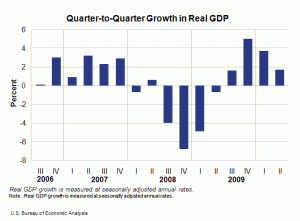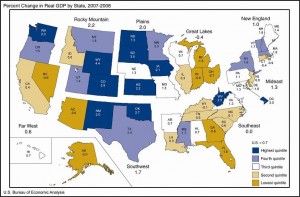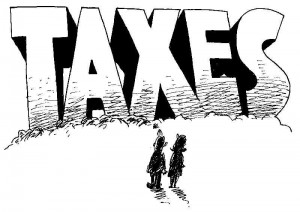Blog #4 – Lots of Debt = Public discontent?
This past week we looked at the events leading up to the Constitutional Convention and included the debt-ridden, farmers’ rebellion known as Shays’ Rebellion that occurred in 1786-87. Because of rampant inflation and other economic factors, former Revolutionary War soldiers couldn’t pay off their mortgages and were faced with jail time in debtors prison, seizure of valuable property or foreclosure on their homes. To prevent the foreclosure of their homes, the farmers in rural Massachusetts, led by Daniel Shays, closed courthouses all around Massachusetts. Only when a private militia (hired by the moneyed interests of Boston) opened fire on the mutinous men of the rebellion did it finally end.
An event like this convinced those on the fence that a stronger central gov’t. was needed to deal with the systemic problems of the Articles of Confederation.
Today, some groups like the Tea Party advocates (Tea standing for Taxed Enough Already) believe that we have drifted far away from this founding legacy of “small government” and that our current gov’t. is way too strong and intrusive in our lives. We see this intrusion in regulations on corporations and other businesses, excessive federal spending, and changes to health care. Many of these groups appear to be grass-roots and decentralized, lack a specific political platform, have a little bit of party money and haven’t rallied around a national leader, according to The Washington Post’s survey of the nation’s TEA Parties published on Oct. 24.
Virtually all of the 650 groups surveyed identified opposition to President Obama’s and the Democratic Party’s policies. The groups also identified economics as a major concern, and this is no surprise considering the country’s economic mess since 2007. 
As you can see by the chart on the left, the US economy finally came out of its epic doldrums in 2008 in 2009 with some small signs of growth. For the first two quarters of 2010, there has also been growth as well (3.7% 1st qtr., 1.7% 2nd qtr), but nothing major.
As shown in the graph below in GDP growth/loss by states, Michigan and Florida had the worst GDP losses in 2007-08 (the yellowish states are the worst hit by this recession).  (1)
(1)
In the summer of 2010, home foreclosures hit a record high of almost 270,000 homes in the 2nd qtr (2). Some of these foreclosures have been questioned b/c it appears that many banks may have kicked people out of their homes w/o “reading the documents.” According to Fox News, in the latest 3rd qtr, almost 290,000 homes were foreclosed, and the banks are on pace to hit 1.2 million by the end of the year (3).
Like the farmers in Shays Rebellion, many homeowners have either lost their homes to foreclosure or seen the value of their house drop so significantly that the mortgage isn’t worth paying off (called an underwater mortgage). Therefore, a number of people have walked away from their homes and let the banks have them. Currently, over 1/2 million homes are owned by banks that aren’t even on the market (3).
Tea Parties have complained a lot about taxes. They’ve also complained, and rightly so, about out-of-control government spending.
If you ever wondered how much money is taken in by the government in taxes, here’s a breakdown:
The federal Government will take in $2.6 trillion for FY2011. The individual taxpayer — you — provides the bulk of this. Here’s how:- Income taxes contribute 45%.
- Social security taxes are 34%.
- Corporate taxes are only 12%.
- Excise taxes and other make up the remaining 9%. (4)
How is it that corporations only pay 9% of our tax burden? Maybe that’s where the gov’t. and Tea Partiers should look for more money.
Or maybe the gov’t. should do with less like the rest of us, especially those who are directly affected by the auto industry. Would it hurt the nation terribly to cut all expenses by 1-2% for the next year? It probably would, but how much has the government’s stimulus package really benefited the country?
The worst part about all of this is that when the country needs the two parties to work together to get us out of this mess, the parties are at a historical point of fighting with each other. Not since the end of World War 2 have the two parties voted only for their own party’s programs and voted against the other party’s program. Between 85-90% of each party’s members have voted for their own bills and against the other party (5).
So, what do we do?
Your question (pick two of the following):
1. Do you think an armed rebellion like Shays could happen today based upon home foreclosures or another source of discontent? Why or why not?
2. Why don’t you think the federal government is willing to cut expenses even slightly to either cut taxes or to reduce our federal budget deficit?
3. What do you think the long-term consequences will be with so many homes being foreclosed, especially this year?
4. Do you think the Tea Party protest is just a one-time thing like the Bull Moose Party (1912) or the States’ Rights Party (1948)? Or will it be around to be a real contender in 2012? Why or why not?
250 words minimum.
Take a look at partisan politics during the Jefferson and Madison administrations:
Sources:
1. http://www.bea.gov/newsreleases/glance.htm
2. http://articles.latimes.com/2010/jul/15/business/la-fi-foreclosures-20100715
3. http://www.foxnews.com/politics/2010/10/14/record-number-foreclosures-face-challenge-court/
4.http://useconomy.about.com/od/fiscalpolicy/tp/US_Federal_Budget.htm
5. Brownstein, Ronald. The Second Civil War: How Extreme Partisanship has Paralyzed Washington and Polarized America. Penguin Press, NY. 2008.

